
35 minute read
› Water Harvesting from Desert Air
Cheng-Hsin Liu
Cheng-Hsin Liu is pursuing a B.S. in Chemical and Biomolecular Engineering at the University of California, Berkeley. He is currently working with Professor Omar M. Yaghi on the structure modeling and characterization of reticular structures for carbon capture and other clean energy applications.
Advertisement
Ha L. Nguyen
Ha L. Nguyen received his Ph.D. from the University of Technology Ho chi minh, Vietnam. He has been working with Professor Omar M. Yaghi at the University of California, Berkeley as a postdoctoral researcher. His research is focused on the structural design of reticular materials for energy applications.
Omar Yaghi
Omar M. Yaghi obtained his Ph.D. from the University of Illinois-Urbana and was an NSF Postdoctoral Fellow at Harvard University. He currently holds the James and Neeltje Tretter Chair Professor of Chemistry at the University of California, Berkeley. He is the Founding Director of the Berkeley Global Science Institute and the Co-Director of the Kavli Energy NanoScience Institute. He is known for establishing reticular chemistry and developing new classes of porous, crystalline solids, termed metal-organic frameworks and covalent organic frameworks. He has been recognized by awards from fifteen countries, including the Wolf Prize in Chemistry (2018), U. S. National Academy of Sciences (2019), and the Royal Society of Chemistry Sustainable Water Award (2020).
by Cheng-Hsin Liu, Ha L. Nguyen, and Omar M. Yaghi
https://doi.org/10.51167/acm00007
Although chemists in general are concerned with the art and science of constructing molecules and understanding their behavior, for a long time the idea that such molecules can be linked together by strong bonds to make infinite, extended structures was fraught with failure. The notion of using molecular building blocks to make such structures invariably led to chaotic, ill-defined materials and therefore not only defying the chemists’ need to exert their will on the design of matter but also preventing them from deciphering the atomic arrangement of such products. The field remained undeveloped for most of the twentieth century, and it was taken as an article of faith that linking molecules by strong bonds to make extended structures is a “waste of time” because “it doesn’t work.”
ALTHOUGH CHEMISTS IN general are concerned with the art and science of constructing molecules and understanding their behavior, for a long time the idea that such molecules can be linked together by strong bonds to make infinite, extended structures was fraught with failure. The notion of using molecular building blocks to make such structures invariably led to chaotic, ill-defined materials and therefore not only defying the chemists’ need to exert their will on the design of matter but also preventing them from deciphering the atomic arrangement of such products. The field remained undeveloped for most of the twentieth century, and it was taken as an article of faith that linking molecules by strong bonds to make extended structures is a “waste of time” because “it doesn’t work.”
This state of affairs was changed when a little known contribution was published 1994, where it was shown that negatively charged germanium sulfide clusters can be linked by positively charged manganese ions to make an extended structure (Figure 1).1 This was the first successful demonstration of linking molecular building blocks by strong bonds to make solid-state materials. The fact that the product was made in crystalline form and that the original clusters were translated into the crystal had two immediate ramifications: The crystallinity led to atomic level identification of the resulting structure while the preservation of the cluster geometry meant that in future the ability to predict accurately the outcome of such syntheses might become real especially since the cluster units are directional. There were additional advantages which became central to this emerging field. For example, the cluster constituents and their linkage (strong metal-sulfide bonds) provided the potential for making robust structures, and in the present case these
encompassed space filled with the organic counterions — space that is ensured by the large size of the cluster building units.
The success here was driven by a bold guess not very much unlike that spoken of by Newton. The guess was that it should be possible to balance the thermodynamics of making the necessary bonds with the kinetics of making and breaking these bonds to control crystallization of the resulting extended structure. Intuitively, the guess emerged from the recognition that nature is so rich and our knowledge of this richness is so primitive that it made sense to actually run the building block reaction stated above and see whether nature would give a crystalline product. This ‘faith’ in nature’s ability to reveal itself and guide those who are of the prepared mind awaiting her offerings is paramount to arriving at a discovery imagined by those who dare to have a bold guess. This original contribution involving the manganese germanium sulfide framework put the seeds in place for the development of what we now know as reticular chemistry whose definition includes the three important fundamental advances illustrated by the successful synthesis of this very framework. It is defined as the linking of molecular building blocks by strong
No great discovery was ever made without a bold guess.”— Isaac Newton
bonds to make crystalline extended structures. 2,3 In this article, we share with the readers how based on the thinking provided by that first contribution, large classes of metal-organic frameworks (MOFs) and covalent organic frameworks (COFs) have been developed, members of which have the property of harvesting water from desert air and the potential to solve the world’s water stress challenge.
All the advantages imparted by the use of clusters as building units did not at this point include the ability to functionalize what eventually would be open pores in such frameworks. Accordingly, attention was focused on the incorporation of organic molecules as building units and these would preferably be charged in order to enhance the bonding strength with metal ions. However, first it was useful to demonstrate that crystalline materials can be made by combining transition metal ions with charged organic linkers. Indeed, in a 1995 report,4 carboxylate organic molecules (1,3,5-benzenetricarboxylate) were linked by cobalt ions to make a layered MOF where the unique synthetic condition developed led to its attainment in crystalline form (Figure 2). This report was immediately followed by several additional examples showing that the carboxylate linkage forms multi-metallic clusters, termed secondary building units (SBUs), 5 which were directional, robust, and rigid, and therefore excellent objects to combine with organic linkers and make porous MOFs.
An important illustration of the SBU approach came in 1998 when 1,4-benzenedicarboxylate was linked by zinc ions to make what is known as MOF-2 (Figure 3) whose structure is composed of di-nuclear metal nodes linked into a layered structure with pores filled with N,N-dimethylformamide molecules.6 The assessment of MOF-2 porosity was done by evacuating the pores and measuring nitrogen adsorption isotherms at low pressure and temperature: The conditions that are recommended by the IUPAC and used as the gold standard for evaluating porosity in materials. From these isotherms the pore volume and internal surface area were derived for the material. The isotherms for MOF-2 were the first measurements made on any metal-organic porous material and proved its permanent porosity.
1
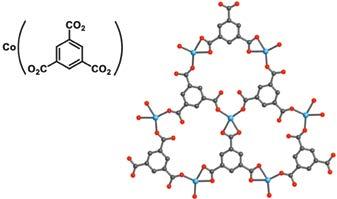
3 2 Figure 1: Crystalline inorganic extended structure from molecular building blocks.

Figure 2: Metal ions joined by charged organic linkers to make metal-organic frameworks (MOFs) in crystalline form.
Figure 3: The carboxylate linkers form di-metallic units (secondary building units, SBUs), to make architecturally robust, porous MOFs.
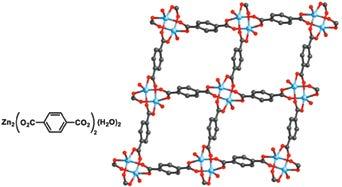
This demonstrates that the SBU approach for making MOFs leads to architecturally robust structures that can sustain their porosity in the absence of any molecular ‘guests’ in the pores. In 1999, the same SBU approach was used to link the basic zinc acetate cluster with 1,4-benzenedicarboxylate and give a crystalline solid whose structure is referred to as MOF-5 (Figure 4, labelled as IRMOF-1).7 Its three dimensional porous structure exhibited ultrahigh porosity exceeding all previous values obtained for the traditional porous solids be they crystalline or amorphous.
At this juncture, it is useful to mention that the SBU approach, the strong metal ioncharged linker bonds, the gas adsorption measurements to prove permanent porosity, and the ultrahigh porosity of these early MOFs became the preferred methods and strategies for the further development of MOF chemistry. Today, nearly all MOFs reported use (a) the same or similar synthesis and crystallization conditions to those used for these early MOFs, (b) the SBU approach outlined above, and (c) the same gas adsorption measurements to evaluate and study their porosity. On a foundational level, the success of the building block approach was extended from the very early examples of all inorganic metal-sulfide frameworks to metal-organic frameworks where the latter combined two fields of chemistry inorganic and organic into one, and extended molecular metal-organic chemistry into infinite 2D and 3D structures.8
The power of reticular chemistry was illustrated in 2002 by the synthesis of MOF-5 derivatives whose pores can be functionalized and expanded without changing their underlying connectivity (termed isoreticular MOFs or MOFs having the same topology, Figure 4).9 Crystal structures of MOF-5 dosed with argon and nitrogen revealed the adsorptive sites within the pores and also explained the ultrahigh porosity of MOFs.10 The more exposed edges and faces of the linkers, the higher the number of adsorptive sites and therefore the higher the internal surface area. This discovery was followed with many reports of MOFs whose structures were replete with adsorptive sites and accordingly their surface areas far exceeded earlier examples.11-14 One gram of these new MOFs has the surface area of several football fields!
Anyone can find the ‘switch’ after the lights are on.”— Confucius
With these developments in place the stage was set for expansion of reticular chemistry with the original contributions serving as pillars for the work reported from 2002 to 2010. The community elaborated the use of the SBU approach in making MOFs based on variously shaped building units, studied their gas adsorptive properties, and aimed for applications based on putting to use the ultrahigh surface area of MOFs.15-25 In this period, at least two major discoveries were made which later were used to vastly enrich reticular chemistry: First, the mixing of functionalities and metal ions in a specific MOF structure to make multivariate MOFs expanded the scope of the chemistry and its applications.26,27 The multivariate MOFs were found to exhibit gas adsorptive properties that significantly exceeded the sum of the corresponding MOFs having unmixed functionality or metals. Second, post-synthetic modification of MOFs brought to the forefront the idea of using frameworks as molecules, in that a framework can be modified by carryout organic reactions on its linkers or exchange of the metals in the SBU without loss of its crystallinity or backbone structure.28,29 These two developments dominated the chemistry of MOF for the next decade (2010-2020) and had the impact of not only bringing the precision of molecular chemistry to the solid-state but also
4 5
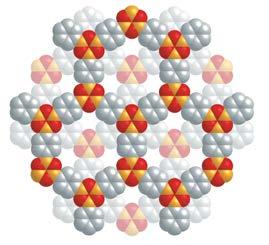
6
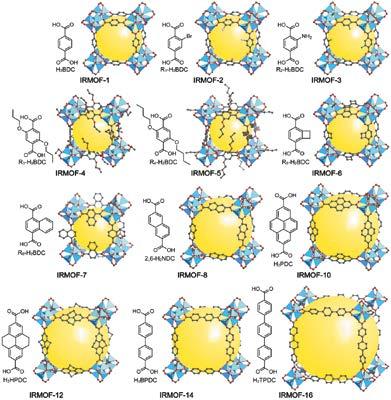
Figure 4: MOF-5 (labelled as IRMOF-1) and its isoreticular functionalized and expanded MOFs. Figure 5: Covalent organic framework-1 composed entirely of light atoms linked by covalent bonds to make a 2D frameworks. Figure 6: 3D covalent organic framework whose structure is the lightest of all solid compounds.
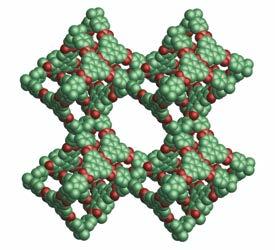
adding to chemistry the concept of multi-variation as means of storing unique chemical information in the pores of MOFs in the form of organic functionality domains and metal ion sequences.30,31
Don’t Sleep Through the Revolution.” — Martin Luther King, Jr.
These developments were taking place alongside another revolution which was launching in the organic chemistry front. Specifically, the first covalent organic frameworks (COFs) were successfully synthesized and crystallized in 2005 and 2007 (Figure 5 and 6).32,33 Unlike MOFs, COFs were entirely composed of light elements such as boron, carbon, oxygen, and nitrogen being linked by covalent bonds. From 2005-2010, robust synthetic conditions for the crystallization of COFs were developed, their porosity was measured, and their use in gas adsorption and storage were examined.34-36 Studies showing how COFs can be placed on surfaces and electronic devices can be constructed from these new materials were reported from the period of 2010-2020.37 This decade witnessed an exponential growth of COF chemistry. The key milestones dealt with extending the chemistry originally developed for the early COFs using boroxine and boronate ester linkages to imines, hydrazones, imide, phenazines, dioxane, urea, esters, and ethylene.38-44 For linkages that were more difficult to crystallize such as amides, amines, and oxazoles, post-synthetic linkage conversion of the imine to these new linkages were successful.45-49 Today, research into COFs is increasing at an exponential rate and the revolution being experienced with MOFs is currently rivaled only by that of COFs.
I don’t just paint something I have in mind. I paint to find out what I have in mind.” — Enrique Martinez Celaya
There was a period where MOFs and COFs were being made just to find out what exactly is possible and what these products might teach us about reticular chemistry. If indeed we can predict every structure we can think of, chemistry would be very boring and not a worthwhile endeavor.
Thus exploration for the sake of discovery and letting nature reveal to us what might not have been in our mind is at the heart of reticular chemistry. This approach was increasingly being practiced in the study and discovery of new properties for MOFs and COFs. Indeed, it is this very approach that has led us to uncover the unique water uptake behavior of MOFs. Prior to this point the fact that MOFs and COFs have been shown to be architecturally, chemically, and thermally robust, coupled with their ultrahigh surface area, meant that gas adsorption was a sound direction for exploitation of these properties. Considering that hydrogen, methane, carbon dioxide, and water are some of the smallest molecules known, they impact our energy, environment, sustainability, and water outlook. The storage of the first three in MOFs and COFs were heavily studied and showed quite promising results for commercialization.50

Figure 7: Nearly one-third of the world population lives in water stressed regions (red in the middle and bottom). MOFs are capable of harvesting water from the arid air of these regions and delivering clean water. Unlike other materials and technologies, MOFs are the only materials known to work anytime, anywhere.
If I have seen further than others, it is by standing upon the shoulders of giants.” — Isaac Newton
Today reticular chemistry is one of the fastest growing fields of science, it is being researched in over one-hundred countries with a plethora of applications advancing to commercialization. This emerging field has at its core inorganic and organic chemistry but it also adds the new chemistry of using the strong metal-ion-based bonds and covalent bonds to link molecules into extended structures, features unattainable prior to reticular chemistry. Thus, it is useful to make a distinction between reticular chemistry and supramolecular chemistry, where the earlier is concerned with linking molecules into extended structures by strong and covalent bonds, while the latter has been defined to be concerned with linking molecules by weak intermolecular forces such as hydrogen bonds.51 Clearly each chemistry requires different reactions and skills in the laboratory and each chemistry is distinct in terms of the objects it leads to and the uses thereof. Indeed, the water harvesting from desert air application was only made possible by the fact that the MOFs are based on strong linkages and therefore robust structures that can be architecturally stable to maintain their porosity, chemically stable to maintain their uptake and release of water, and thermally stable to maintain their function under the elevated temperatures in the desert for many years of deployment. We emphasize that our preoccupation with developing the chemistry of the strong bond in the solid state and therefore in materials is not just an intellectual obsession but it is a worthwhile endeavor, which is leading to forefront solutions to some of the most pressing problems facing our planet in areas such as carbon capture and water.
Droplets of life
Water harvesting from air is an idea that has been pursued since time immemorial. In humid areas of the world where air contains over 10 g of water per cubic meter, there are many approaches known to harvesting water. Fog collecting and methods relying on direct cooling of air to condense water are still being practiced today. However, at lower humidity (<10 g of water per cubic meter) no viable materials existed prior to reticular materials. It is useful to outline the criteria a material must meet in order to be capable of efficiently harvesting water from air. First, it has to be able to capture water at low humidity where almost one-third of the world population lives and experience water stress most of the year, another one-third of the world population lives in areas where they experience water stress for at three to six months of the year (Figure 7). Second, it should operate with fast kinetics, where water uptake and release occurs rapidly to allow sufficient water to be produced. Third, it should have high capacity in order to avoid excessive number of cycles and additional energy cost for cycling. At present, the materials being tested are broadly represented
by zeolites, porous polymers, and inorganic salts — all fail in meeting one or more of these criteria. A viable material must meet all three criteria.52
In the study of carbon dioxide capture from flue gas, the separation of carbon dioxide from water is a key step in the success of the process. In 2014, while studying a zirconium (IV) MOF (MOF-841) for its carbon dioxide capture properties, it was intriguing to find that it took up significant amounts of water from gas mixtures.53 This observation in itself was unexceptional as many MOFs and other materials take up water; however, up to that point none were exhibiting the properties of this MOF. MOF841 took up water in voluminous amounts at relative humidity (R.H.) down to almost 25%, and where binding water into its pores by what appears to be a cooperative mechanism, giving a ‘knee’ shaped water uptake isotherm. The other remarkable observation from this study was the fact that the adsorbed water can be removed at relatively low temperature (45°C). Taken together these findings indicated that MOF-841 could be exposed to desert air at night to take up water, which would then be harvested by removing it from the pores during the day when the temperature is higher and thereby providing access to drinking water. In essence the action of the MOF was to provide means of taking water from low humidity air and concentrating it so that when the MOF is heated in a closed system, high humidity is generated and condensation of water can easily take place by the temperature gradient existing between the ambient and that inside of the box.
The MOF is constructed on the molecular level from metal-oxide units linked by organic linkers, each programmed to fit together as in a 3D Jigsaw puzzle and to yield an infinite arrangement encompassing space within which water can be adsorbed. There are several unique properties exhibited by water harvesting MOFs discovered since MOF-841: First, they have built into their pores specific adsorptive sites to which water can freely bind. These sites are hydrophilic (water ‘loving’) and therefore can attract water from low humidity air where its concentration is preciously low. Second, we know that the very first water molecules to get into the pores and reside on those binding sites attract other water molecules to form small water aggregated seeds unto which progressively increasing amounts of water bind through making hydrogen bonds and ultimately filling the pores. This is another way of saying the water binding follows a cooperative mechanism where the more water molecules are on the binding sites, the more water gets attracted into the pores from the atmosphere. Third, the fact that the MOF composed of hydrophilic (metal-oxide units) and hydrophobic (segments of the organic linkers) regions makes its vast pore system ideally suited for accumulating water through the cooperative mechanism without holding onto water too tightly. This means relatively mild temperature is applied to remove water from the pores for harvesting. These three unique properties have a direct impact on the water harvesting capacity, kinetics of uptake and release, and the energy required to harvest water using MOFs.
To show the viability of MOFs as practical water harvesting materials, a box within a box construct was built and charged with one kilogram of another MOF (MOF-801) (Figure 8).54 This MOF was shown in the laboratory to take up water from even lower humidity (R.H. of 10%) than MOF-841 and therefore was an ideal candidate to be tested in the desert. The inner box is kept open at night to allow water in the atmosphere to enter the MOF. It’s then shut during the day and exposed to sunlight. As the interior of the box heats up, water is released and condensed on the walls of the box. This box device was tested in the Arizona desert and found to deliver 200-300 mL of water per kilogram of MOF per day at 5-40% R.H. and 20-40 °C. The success in harvesting water from this simple box within a box construct was truly transformational since it is the first time in history for water from desert
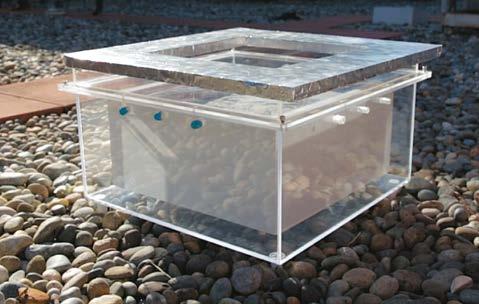
Figure 8: Second generation MOF water harvester tested in the Arizona desert. Boxin-a-box design capable of harvesting water from air with no energy input aside from ambient sunlight.
Figure 9: Third generation MOF water harvester tested in Mojave desert. It is powered by a solar panel to allow multiple cycles of water uptake from air and collection of water.

air was harvested in this manner. It is all the more remarkable that this was done using an uncomplicated setup of two plexiglass boxes and with only energy input from ambient sunlight.
The Arizona field test was extremely helpful in the development of what later was termed the MOF water harvester. It demonstrated that: (1) the MOF is thermally and chemically stable under real world conditions, and therefore potentially, as illustrated in later versions, it can be cycled multiple times to harvest more water, (2) the water harvested was tested for impurities and found to be ultrapure with no metal or organic contaminants detected; an aspect that is also supported by the fact that the MOF is a molecular filter only allowing water into its pores and rejecting any undesirable species that might be in the air, and (3) since the MOF works at such a low humidity, it meant that it can be deployed at any other higher humidity; thus making it possible to envision the use of MOFs for harvesting water anytime of the year, anywhere in the world.
The attention was directed at building a MOF water harvester capable of multiple cycles and this naturally would require some power input such as from a solar panel. For this generation of water harvesters, a new MOF was discovered, MOF-303 Al(OH)(1H-pyrazole3,5-dicarboxylate). It has a porous, crystalline structure, composed of rod metal-oxide units linked by pyrazole units leading to an overall 3D structure with 1D pores. Initial experiments in the laboratory showed that MOF-303 was capable of extracting water at very low humidity (<7% R.H.) and significantly it can take up water and release with great facility. These observations meant that several cycles can be carried out for the adsorption-desorption of water within an order of minutes at 85 °C. In this way, significantly higher amounts of water per kilogram of MOF can be harvested.55 Accordingly, a multi-stage device composed of a number of MOF cartridges was designed and constructed, then charged with a total of one kilogram of MOF-303. It was tested in the Mojave Desert under extreme humidity 10% RH and 27 °C. It delivered 0.7-1.0 L water per kilogram of MOF per day (Figure 9), which is an order of magnitude more than the passive box within a box harvester.
With these developments at hand, efforts are underway to build a precommercial water harvester (Figure 10). Preliminary results along these lines show that it is possible design and construct a table top device capable of more than 200 cycles per day, requiring minimal energy, and delivering up to 40 L per kilogram of MOF per day. This is less than half of the intrinsic capacity of a typical water harvesting MOF, thus it is just a matter of time and engineering before we are able to approach nearly 100 liters per kilogram of MOF per day. There are also plans to build larger devices capable of delivering 250 L and 20,000 L per day.
An important exercise was carried out using the water production parameters and operation conditions of MOF-303 to derive the water productivity of the latest MOF water harvester for cities around the world (Table 1). It turns out that cities in tropical savanna climate (Chennai and Dhaka) would have daily rates as high as 90 L of water per kilogram of MOF. It is quite remarkable that 7-20 L of water per kilogram of MOF is achievable in the driest deserts of the world (Mojave and Atacama). For cities with hot desert climate (Baghdad, Riyadh), even though the R.H. is low (14% for Riyadh in August) during the hot summer, the expected daily rates are 30 L water per kilogram of MOF per day.56
These laboratory to desert experiments proved very convincingly the MOF capability in harvesting and delivering ultrapure water from desert climate where humidity and the concentration of water in air are low. No other material can perform with the same efficiency and under these extreme conditions. These findings potentially make available to society another source of clean water that is recyclable and sustainable. The MOF material is also recyclable and it has sustainable method of making it with zero discharge. Since the lifetime of the MOF is that of the device (anticipated to be 6-10 years), the MOF can remain in the device without having to be replaced. At the end of the device life and the MOF peak performance, the MOF can be dissociated into its constituent building blocks and remade into its original form in water and with no waste.
It is not anticipated that the MOF water harvester will replace the current cheap sources of water but at least in terms of overall costs to consumer, water obtained from the MOF water harvester costs only a fraction of that currently marketed as bottled water. Water Harvesting Inc., a startup pursuing the commercialization of the MOF water harvester, has already made viable business plans to provide water as a service to communities where it is most needed. With all costs taken into account the cost of drinking water for a family of four will not exceed one dollar per day. This is a significant step in the right direction for making clean water accessible to everyone on our planet. The vision is to create water independence for citizens of the world and make water a human right.
The best way to predict the future is to create it.” — Abraham Lincoln
To appreciate the current state of reticular chemistry, it is helpful to step back and consider the materials serving humanity thus far. Many would agree that steel, aluminum, silicon, cement, glass, wood, polymers, pharmaceuticals, petroleum, paper, and fabrics, represent prominent examples where ecosystems were

Figure 10: A table top MOF water harvester (fourth generation) delivering 4 L per day in desert climate and using 100 g of MOF.
Table 1: Minimum and maximum amounts (depending on time of year) of water the MOF is expected to deliver in various cities around the world.
City Minimum water delivery amount (L/kg of MOF/day) Maximum water delivery amount (L/kg of MOF/day)
Chennai 77 93
Cape Town Dhaka 48 49 67 96
Perth 39 53
Delhi 43 94
Baghdad Rome Granada 38 36 34 46 72 51
London 34 57
Riyadh Los Angeles Stockholm 30 34 24 44 56 68
New York 19 66
Kabul Calama 19 7 47 42
Beatty Lanzhou 16 13 34 60
developed around each one of them. As we entered the twenty-first century, many issues facing our planet have dealt with energy efficiency and renewable, clean environment and air, sustainability and conservation, and access to clean water. Clearly these materials can not address the new challenges facing us in those areas. New kind of chemistry is needed to create new materials which ultimately can effectively solve the new problems. As all these problems are best understood first on the atomic and molecular level, it is natural to believe that viable solutions would likely be found by enhancing our capability to design and precisely control matter on the minute level. The foregoing discussion in this article of how reticular chemistry has led to the harvesting water from desert air and to the successful laboratory to desert trials underlines the power and the unparalleled precision of this new chemistry and its impact on crafting useful materials. What else will be needed to, dare one say, advance MOFs and COFs as the twenty-first century materials?
There is a vast possible structure space resulting from linking building blocks together into new materials and vast possible ways of functionalizing each one of those materials, and therefore in this context reticular chemistry is infinite. Indeed, infinite chemistry, infinite materials, and infinite applications. How do we tame this infiniteness? And bring it to profitable utility in advancing knowledge and industry. It will be essential to digitize reticular chemistry. This can be done by coupling robotics with machine learning and in turn joining the laboratory discovery cycle with the digital discovery cycle as outlined in a recent publication.57 The purpose of this initiative will be to explore the vast structure space and uncover new useful ones, identify structures which could solve specific problems, and develop the new tools of digital reticular chemistry to be routine instruments of learning and discovery along the path spanning the laboratory to commercialization.
Another question being articulated in reticular chemistry today is: How can we build into these highly crystalline and ‘repetitive’ structures unique sequences of information without falling into chaos? The answer can be gleaned by contrasting on a conceptual level the reticular structure with that of DNA. Both have repetitive backbones onto which molecular entities can be bound covalently. As multiple different kind of these entities are attached to the backbone, their spatial arrangements are described in terms of sequences. For DNA, enzymes can sequence and identify the spatial arrangements of nucleotides but the equivalent of this elegant process does not exist for MOFs or COFs into which multiple functionalities can be pinned onto their backbone to make the so-called multivariate MOFs and COFs. Preliminary evidence points to the presence of sequences in these systems. It should be possible to characterize these sequences by studying their properties and working the sequences from how the properties are influenced by their composition. In this regard, the artificial intelligence tools mentioned above will be indispensable. The dream is to make structures into which sequences are designed to code for specific properties. This is not far from reality as it was already shown that multivariate MOFs exhibit properties that go beyond the sum of their parts.
Twenty-five years ago, the experiment was tried because of a bold guess and this has led to infinite possibilities which, as exemplified by the case of water harvesting from air, made all the difference in creating a path for addressing vexing societal problems. Above all else, it is useful to remark that it was originally based on answering an intellectual challenge and the result has been exciting new chemistry and impactful applications. It is apparent that we have only scratched the surface, with much more of reticular chemistry is yet to come. ◆

References
1. Yaghi, O.M., Sun, Z., Richardson, D.E. and Groy,
T.L. (1994). Directed transformation of molecules to solids: synthesis of a microporous sulfide from molecular germanium sulfide cages. J. Am. Chem.
Soc. 116, 807-808. 2. Yaghi, O.M., Kalmutzki, M.J. and Diercks, C.S. (2019). Introduction to Reticular Chemistry:
Metal-organic frameworks and covalent organic frameworks. 509 (Wiley-VCH, Weinheim). 3. Yaghi, O.M., O’Keeffe, M., Ockwig, N.W., Chae,
H.K., Eddaoudi, M. and Kim, J. (2003). Reticular synthesis and the design of new materials. Nature 423, 705-714. 4. Yaghi, O.M., Li, G. and Li, H. (1995). Selective binding and removal of guests in a microporous metal–organic framework. Nature 378, 703-706. 5. Li, H., Davis, C.E., Groy, T.L., Kelley, D.G. and
Yaghi, O.M. (1998). Coordinatively Unsaturated
Metal Centers in the Extended Porous
Framework of Zn3(BDC)3·6CH3OH (BDC = 1,4-Benzenedicarboxylate). J. Am. Chem. Soc. 120, 2186-2187. 6. Li, H., Eddaoudi, M., Groy, T.L. and Yaghi, O.M. (1998). Establishing microporosity in open metalorganic frameworks: gas sorption isotherms for
Zn(BDC) (BDC = 1,4-Benzenedicarboxylate). J. Am.
Chem. Soc. 120, 8571-8572. 7. Li, H., Eddaoudi, M., O’Keeffe, M. and Yaghi, O.M. (1999). Design and synthesis of an exceptionally stable and highly porous metal-organic framework.
Nature 402, 276-279. 8. Jiang, J., Zhao, Y. and Yaghi, O.M. (2016). Covalent chemistry beyond molecules. J. Am. Chem. Soc. 138, 3255-3265. 9. Eddaoudi, M., Kim, J., Rosi, N., Vodak, D., Wachter,
J., O’Keeffe, M. and Yaghi, O.M. (2002). Systematic design of pore size and functionality in isoreticular
MOFs and their application in methane storage.
Science 295, 469-472. 10. Rowsell, J.L., Spencer, E.C., Eckert, J., Howard,
J.A. and Yaghi, O.M. (2005). Gas adsorption sites in a large-pore metal-organic framework. Science 309, 1350-1354. 11. Chae, H.K., Siberio-Perez, D.Y., Kim, J., Go, Y.,
Eddaoudi, M., Matzger, A.J., O’Keeffe, M. and
Yaghi, O.M. (2004). A route to high surface area, porosity and inclusion of large molecules in crystals.
Nature 427, 523-527. 12. Furukawa, H., Ko, N., Go, Y.B., Aratani, N., Choi,
S.B., Choi, E., Yazaydin, A.Ö., Snurr, R.Q., O’Keeffe,
M., Kim, J. and Yaghi, O.M. (2010). Ultrahigh porosity in metal-organic frameworks. Science 329, 424-428. 13. Farha, O.K., Eryazici, I., Jeong, N.C., Hauser, B.G.,
Wilmer, C.E., Sarjeant, A.A., Snurr, R.Q., Nguyen,
S.T., Yazaydın, A.O. and Hupp, J.T. (2012). Metal–organic framework materials with ultrahigh surface areas: Is the sky the limit? J. Am. Chem. Soc. 134, 15016-15021. 14. Hönicke, I.M., Senkovska, I., Bon, V., Baburin, I.A.,
Bönisch, N., Raschke, S., Evans, J.D. and Kaskel, S. (2018). Balancing mechanical stability and ultrahigh porosity in crystalline framework materials. Angew.
Chem. Int. Ed. 57, 13780-13783. 15. Kalmutzki, M.J., Hanikel, N. and Yaghi, O.M. (2018).
Secondary building units as the turning point in the development of the reticular chemistry of MOFs.
Sci. Adv. 4, eaat9180. 16. Bai, Y., Dou, Y., Xie, L.H., Rutledge, W., Li, J.R. and Zhou, H.C. (2016). Zr-based metal–organic frameworks: design, synthesis, structure, and applications. Chem. Soc. Rev. 45, 2327-2367. 17. Howarth, A.J., Peters, A.W., Vermeulen, N.A.,
Wang, T.C., Hupp, J.T. and Farha, O.K. (2017).
Best practices for the synthesis, activation, and characterization of metal–organic frameworks.
Chem. Mater. 29, 26-39. 18. Odoh, S.O., Cramer, C.J., Truhlar, D.G. and
Gagliardi, L. (2015). Quantum-chemical characterization of the properties and reactivities of metal–organic frameworks. Chem. Rev. 115, 6051-6111. 19. Zhang, T. and Lin, W. (2014). Metal–organic frameworks for artificial photosynthesis and photocatalysis. Chem. Soc. Rev. 43, 5982-5993. 20. Imaz, I., Rubio-Martínez, M., An, J., Sole-Font,
I., Rosi, N.L. and Maspoch, D. (2011). Metal–biomolecule frameworks (MBioFs). Chem.
Commun. 47, 7287-7302. 21. Guillerm, V., Kim, D., Eubank, J.F., Luebke, R., Liu,
X., Adil, K., Lah, M.S. and Eddaoudi, M. (2014). A supermolecular building approach for the design and construction of metal–organic frameworks.
Chem. Soc. Rev. 43, 6141-6172. 22. Lin, R.B., Xiang, S., Xing, H., Zhou, W. and Chen,
B. (2019). Exploration of porous metal–organic frameworks for gas separation and purification.
Coord. Chem. Rev. 378, 87-103. 23. Wu, D., Guo, Z., Yin, X., Pang, Q., Tu, B., Zhang,
L., Wang, Y.G. and Li, Q. (2014). Metal–organic frameworks as cathode materials for Li–O2 batteries. Adv. Mater. 26, 3258-3262. 24. Jiang, H., Liu, X.C., Wu, Y., Shu, Y., Gong, X., Ke,
F.S. and Deng, H. (2018). Metal–organic frameworks for high charge–discharge rates in lithium–sulfur batteries. Angew. Chem. 130, 3980-3985. 25. Moreau, F., Kolokolov, D.I., Stepanov, A.G., Easun,
T.L., Dailly, A., Lewis, W., Blake, A.J., Nowell, H.,
Lennox, M.J., Besley, E., Yang, S. and Schröder, S. (2017). Tailoring porosity and rotational dynamics in a series of octacarboxylate metal-organic frameworks. Proc. Natl. Acad. Sci. U. S. A. 114, 3056-3061. 26. Wang, L.J., Deng, H., Furukawa, H., Gándara, F.,
Cordova, K.E., Peri, D. and Yaghi, O.M. (2014).
Synthesis and characterization of metal–organic framework-74 containing 2, 4, 6, 8, and 10 different metals. Inorg. Chem. 53, 5881-5883. 27. Deng, H., Doonan, C.J., Furukawa, H., Ferreira,
R.B., Towne, J., Knobler, C.B., Wang, B. and Yaghi,
O.M. (2010). Multiple functional groups of varying ratios in metal-organic frameworks. Science 327, 846-850. 28. Wang, Z. and Cohen, S.M. (2007). Postsynthetic covalent modification of a neutral metal−organic framework. J. Am. Chem. Soc. 129, 12368-12369. 29. Morris, W., Doonan, C.J., Furukawa, H., Banerjee,
R. and Yaghi, O.M. (2008). Crystals as molecules:
Postsynthesis covalent functionalization of zeolitic imidazolate frameworks. J. Am. Chem. Soc. 130, 12626-12627. 30. Kong, X., Deng, H., Yan, F., Kim, J., Swisher, J.A.,
Smit, B., Yaghi, O.M. and Reimer, J.A. (2013).
Mapping of functional groups in metal-organic frameworks. Science 341, 882-885. 31. Ji, Z., Li, T. and Yaghi, O.M. (2020). Sequencing of metals in multivariate metal-organic frameworks.
Science 369, 674-680. 32. Cote, A.P., Benin, A.I., Ockwig, N.W., O’Keeffe,
M., Matzger, A.J. and Yaghi, O.M. (2005). Porous, crystalline, covalent organic frameworks. Science 310, 1166-1170. 33. El-Kaderi, H.M., Hunt, J.R., Mendoza-Cortés, J.L.,
Côté, A.P., Taylor, R.E., O’Keeffe, M. and Yaghi,
O.M. (2007). Designed synthesis of 3D covalent organic frameworks. Science 316, 268-272. 34. Furukawa, H. and Yaghi, O.M. (2009). Storage of hydrogen, methane, and carbon dioxide in highly porous covalent organic frameworks for clean energy applications. J. Am. Chem. Soc. 131, 88758883. 35. Doonan, C.J., Tranchemontagne, D.J., Glover, T.G.,
Hunt, J.R. and Yaghi, O.M. (2010). Exceptional ammonia uptake by a covalent organic framework.
Nat. Chem. 2, 235-238. 36. Han, S.S., Furukawa, H., Yaghi, O.M. and Goddard
III, W.A. (2008). Covalent organic frameworks as exceptional hydrogen storage materials. J. Am.
Chem. Soc. 130, 11580-11581. 37. Geng, K., He, T., Liu, R., Dalapati, S., Tan, K.T., Li,
Z., Tao, S., Gong, Y., Jiang, Q. and Jiang, D. (2020).
Covalent organic frameworks: design, synthesis, and functions. Chem. Rev. 120, 8814-8933. 38. Uribe-Romo, F.J., Hunt, J.R., Furukawa, H.,
Klock, C., O’Keeffe, M. and Yaghi, O.M. (2009). A
crystalline imine-linked 3-D porous covalent organic framework. J. Am. Chem. Soc. 131, 4570-4571. 39. Uribe-Romo, F.J., Doonan, C.J., Furukawa, H.,
Oisaki, K. and Yaghi, O.M. (2011). Crystalline covalent organic frameworks with hydrazone linkages. J. Am. Chem. Soc. 133, 11478-11481. 40. Fang, Q., Zhuang, Z., Gu, S., Kaspar, R.B., Zheng,
J., Wang, J., Qiu, S. and Yan, Y. (2014). Designed synthesis of large-pore crystalline polyimide covalent organic frameworks. Nat. Commun. 5, 4503. 41. Guo, J., Xu, Y., Jin, S., Chen, L., Kaji, T., Honsho,
Y., Addicoat, M.A., Kim, J., Saeki, A., Ihee, H. and
Seki, S. (2013). Conjugated organic framework with three-dimensionally ordered stable structure and delocalized π clouds. Nat. Commun. 4, 2736 42. Zhang, B., Wei, M., Mao, H., Pei, X., Alshmimri, S.A.,
Reimer, J.A. and Yaghi, O.M. (2018). Crystalline dioxin-linked covalent organic frameworks from irreversible reactions. J. Am. Chem. Soc. 140, 12715-12719. 43. Zhao, C., Diercks, C.S., Zhu, C., Hanikel, N., Pei, X. and Yaghi, O.M. (2018). Urea-linked covalent organic frameworks. J. Am. Chem. Soc. 140, 16438-16441. 44. Zhao, C., Lyu, H., Ji, Z., Zhu, C. and Yaghi, O.M., 2020. Ester-linked crystalline covalent organic frameworks. J. Am. Chem. Soc. 142, 14450-14454. 45. Lyu, H., Diercks, C.S., Zhu, C. and Yaghi, O.M. (2019). Porous crystalline olefin-linked covalent organic frameworks. J. Am. Chem. Soc. 141, 68486852. 46. Waller, P.J., Lyle, S.J., Osborn Popp, T.M.,
Diercks, C.S., Reimer, J.A. and Yaghi, O.M. (2016).
Chemical conversion of linkages in covalent organic frameworks. J. Am. Chem. Soc. 138, 15519-15522. 47. Liu, H., Chu, J., Yin, Z., Cai, X., Zhuang, L. and
Deng, H. (2018). Covalent organic frameworks linked by amine bonding for concerted electrochemical reduction of CO2. Chem 4, 1696-1709. 48. Waller, P.J., AlFaraj, Y.S., Diercks, C.S.,
Jarenwattananon, N.N. and Yaghi, O.M. (2018).
Conversion of imine to oxazole and thiazole linkages in covalent organic frameworks. J. Am. Chem. Soc. 140, 9099-9103. 49. Haase, F., Troschke, E., Savasci, G., Banerjee,
T., Duppel, V., Dörfler, S., Grundei, M.M., Burow,
A.M., Ochsenfeld, C., Kaskel, S. and Lotsch, B.V. (2018). Topochemical conversion of an imine-into a thiazole-linked covalent organic framework enabling real structure analysis. Nat. Commun. 9, 2600. 50. Czaja, A.U., Trukhan, N. and Müller, U. (2009).
Industrial applications of metal–organic frameworks.
Chem. Soc. Rev. 38, 1284-1293. 51. Lehn, J.-M. Supramolecular chemistry—Scope and perspectives molecules, supermolecules, and molecular devices (Nobel Lecture) (1988). Angew.
Chem., Int. Ed. Engl. 27, 89-112. 52. Hanikel, N., Prévot, M.S. and Yaghi, O.M. (2020).
MOF water harvesters. Nat. Nanotechnol. 15, 348-355. 53. Furukawa, H., Gandara, F., Zhang, Y.B., Jiang,
J., Queen, W.L., Hudson, M.R. and Yaghi, O.M. (2014). Water adsorption in porous metal–organic frameworks and related materials. J. Am. Chem.
Soc. 136, 4369-4381. 54. Fathieh, F., Kalmutzki, M.J., Kapustin, E.A., Waller,
P.J., Yang, J. and Yaghi, O.M. (2018). Practical water production from desert air. Sci. Adv. 4, eaat3198. 55. Hanikel, N., Prévot, M.S., Fathieh, F., Kapustin, E.A.,
Lyu, H., Wang, H., Diercks, N.J., Glover, T.G. and
Yaghi, O.M. (2019). Rapid cycling and exceptional yield in a metal-organic framework water harvester.
ACS Cent. Sci. 5, 1699-1706. 56. Xu, W. and Yaghi, O.M. (2020). Metal–organic frameworks for water harvesting from air, anywhere, anytime. ACS Cent. Sci. 6, 1348-1354. 57. Lyu, H., Ji, Z., Wuttke, S. and Yaghi, O.M. (2020).
Digital reticular chemistry. Chem 6, 2219-2241.



